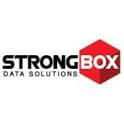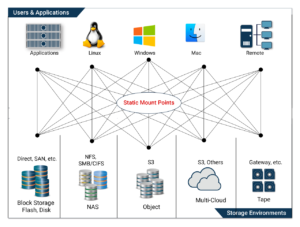If Digital Transformation is Data Centric, Why Then are IT Organizations Storage Centric?
We are living in an unprecedented era of digital transformation that is driving organizations to become data-centric information managers. The world is creating, consuming, processing, and relying on more data than ever. Even the changes to how businesses have adapted to remote operations during the COVID-19 pandemic have only accelerated this process.
The problem is that the data tsunami is putting enormous pressure on all aspects of both private and public cloud data centers. This includes storing, classifying, accessing, analyzing, manipulating, sharing, moving, protecting, and archiving that data, particularly unstructured data. Industry analysts have made it clear this trend is accelerating. The 800 lb. gorilla in the room is data storage.
Data storage has been called the tail that wags the dog when it comes to IT budgets. It is the only data center technology that is consumed versus used. This means that data storage is a continually growing cost center for all data owners. This inevitably increases the pressure to reduce costs, even when data is monetized in ways to help offset those costs.
And storage is not just one thing. Every media type, interface, and system from different vendors has distinctive performance, wear-life, and cost profiles. No one storage type fits all data use cases at all times. The performance requirements for some data use cases may need higher-cost storage for some portion of the data’s life cycle.
Budget pressure to contain or reduce overall expenditures, however, may drive organizations to select lower-cost storage alternatives. Here’s the rub: bridging the extremes of cost and performance is a serious problem, and usually results in an increased load on IT staff, and thus higher operating costs, even as it’s trying to reduce storage costs.
To really deliver value by reducing storage costs, minimizing IT intervention, and achieving better overall utilization, a data-centric, or data management-driven approach is needed that can provide much more intelligence about the data at any point in time in its lifecycle. It must also have the ability to use that intelligence to take action globally across multiple storage types, often from different vendors.
Moving data to a different storage type requires knowledge about which data can and should be moved, when it is effective to do so, and how to ensure users can still access it when it has moved. Data age alone is not enough information to make these decisions. Which data belongs in lower-cost storage and when it should move there requires knowing details about what the data is and how it is used, crucial contextual information that storage systems alone are unable to provide.
Storage-centric approaches tend to lock customers into vendor-specific silos, where moving to other storage types becomes difficult, and risks interrupting user access.
Then why in the world do so many IT organizations try to implement data management using point solutions and other utilities provided by their storage systems? This storage-centric approach to data management adds another layer of complexity to already highly complex systems but without fully addressing the problems. It’s also incredibly costly since most storage vendors license their software by capacity or TBs. This method causes data management costs to grow as data volumes grow. And with unabated data growth, that model is unsustainable.
It’s important to emphasize the fact that such storage-centric approaches to data management are designed to lock customers into that particular storage vendor. Being reliant on a specific storage system’s data management layer makes it very difficult to replace that vendor’s storage, or to add in additional storage tiers from different vendors. When that primary storage system ages out, or becomes non-competitive in performance, cost, scalability, functionality, or other reasons, it becomes very painful to opt for other storage choices if the storage vendor’s data management tools are controlling the data. It is a lock-in strategy that vendors have perfected.
It makes much more sense functionally, financially, and for performance reasons to separate the data management from the storage systems. This alone will cause storage systems to become more commoditized, which significantly lowers storage costs by minimizing silos and automating data placement across any storage type. Separating out the data management from the physical storage platform additionally makes heterogeneous storage substantially simpler to manage, which helps reduce operating expenses.
Many of the functions often provided by storage vendors such as tiering, replication, data protection, disaster recovery, search, active archiving, data movement to/from public cloud storage, and more can now be managed consistently by policy across all storage types based upon a vendor-neutral data-centric approach to storage resource management. This metadata-driven data management approach provides far more benefits from a customer’s perspective, as it frees them from being hostage to a specific storage vendor. In addition, this data-centric strategy empowers them with the data intelligence needed to give them control of their storage costs more effectively and reduce the amount of guesswork and manual intervention by IT staff.
Data typically outlasts the storage it was created on. In this way, by focusing on the data intelligence and providing data-centric tools to automate data management across any storage type, data owners can now focus on their primary asset, which is the data itself, and in so doing empower themselves with the means to reduce the costs and complexity of getting the most value from their existing and future digital assets.


